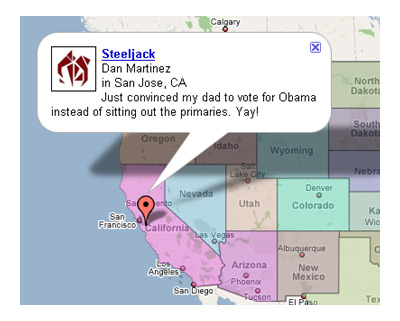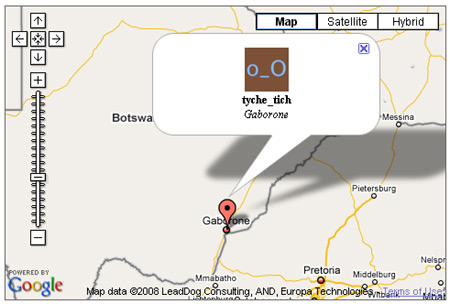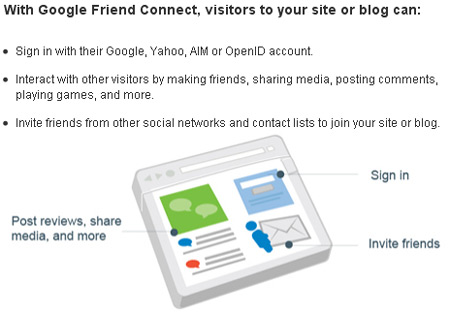What's the most recognised logo in the world? It would probably be Google's if only they could stick to one. Yet as the world's most popular search engine tries out a new favicon, Craig Smith says the old branding rulebook is being rewritten.
It's not the size that matters, it's how often you use it. So the thinking goes at Google, which has just revealed the design of its latest favicon - the tiny logo that shows any web user, on any web browser, anywhere in the world, precisely whose internet "real estate" they are currently residing upon.
An example of a favicon can be seen at the top of this page (so long as you are using an up-to-date enough web browser). Just in front of the URL http://news.bbc.co.uk/... there is a small BBC logo. That 16x16 pixel square is the size of the favicon in question, if not the scope.
 Google's changing masthead 1998 (top) and now |
Now consider that, at the website owner's discretion, the logo appears on every single one of its pages that the world's web population loads. For Google that amounts to upward of 1, 200 million individual searches. Every day.
Add to that its Google News, Google Images, mobile search and multitude of other online services. Suddenly the favicon takes on an importance that belies its fingernail-sized dimensions, and the motivation for Google to roll out its third design in less than a year, as it attempts to get its favicon right, becomes clear.
Google's journey to this latest multi-coloured graphic identity charts a course through some of the unique challenges of favicon design, and through those of logo design in general. The world's leading search engine, whose very name has been adopted as the generic term for finding pages on the web, has achieved web domination without ever having had an actual logo.
Magic Eye style
Think of Google visually and you will probably picture the letters that make up the word Google, picked out in bright primary colours. In the designer's lexicon, rather than being a logo, Google has a logotype - albeit a very successful one around which it is famed for creating ever-changing topical "doodle" themes.
 | DESIGN A FAVICON What makes a good favicon? Here, BBC designer Mick Ruddy suggests four key points 1. Keep it simple - use basic shapes 2. Use a limited colour palette 3. Avoid fine detail or lots of gradients 4. Keep it sharp - keep an eye on blurring |
What Google has so far lacked is the sort of universally recognised icon that identifies a Mercedes-Benz car at distance or, in technology terms, the Apple computer or Yahoo web page - all logos that these brands use as their own favicon, not least because they fit the diminutive dimensions. The word Google, by contrast, would not reduce and still be legible.
Cue the new Google favicon - a rainbow of differently shaped blocks. A bit like one of those "hidden" Magic Eye pictures popular in the 1990s, not everyone will immediately see that the Google favicon blocks interlock to form a "g" shape.
That hardly matters. The design makes best use of favicon limitations and is a marked evolution of Google's previous iterations - a small blue "g" on a white background since June of last year, and a capital "G" before that.
While the old branding rulebook would discourage such regular, radical overhauls, reeking as it does of indecisiveness and inconsistency, in the digital world such rules are temporary, at best.
Steve Plimsoll, of brand consultancy FutureBrand, says the traditional rules on corporate identity are starting to look a little tired.
Mighty morphin logos
"Logos are set to become fluid, ever-changing, customisable, even personalised entities and Google is the first global brand that understands this," says Mr Plimsoll, who is head of digital.
"We are going to have to get used to the idea of our brands changing frequently, and when we do, every three months will seem like the dark ages."
 Remind you of anything? |
If you don't like the new look, then, you can wait or, more proactively, send the company your own design. When Google unveiled the small 'g' last year, the company's head of search products & user experience, Marissa Mayer, hinted at a transitory solution, saying "by no means is the one you're seeing our favicon final; it was a first step to a more unified set of icons" and inviting users to contribute ideas.
The new favicon is based on a design sent in by André Resende, a computer science undergraduate student at the University of Campinas in Brazil.
It may sound indecisive, even amateurish, but the fast-changing nature of Google's digital world dictates it. While the billions of pages of Google's branded "real estate" is the headline figure, its real focus is to keep pace with users' mobile phones, computer task bars and web bookmarks in such a way as to keep directing them effortlessly back to Google - using the favicon as their guide.
For the world's biggest search engine, the world's smallest signpost is one of its most valuable assets.
Craig Smith is a marketing author and editorial director at publishing agency Velo
You've read about Google's new favicon - now design one yourself - either a personal favicon or one to represent the Magazine, and send it to us.
It's easy to do. You can either use one of the many online favicon generators such as favicon.cc, DynamicDrive, Favicon Generator and Galleryor Antifavicon, or just shrink an image down to 16x16 pixels.
Don't forget to think about what makes a good icon at such a small size - see Mick Ruddy's tips in the factbox near the top of this story
Once you've got your favicon - e-mail it to us at yourpics@bbc.co.uk with the subject line "favicon"
Include some personal details - your name, where you are from etc. And a brief sentence about your favicon. We'll publish some of them on this page later.
Some of your Magazine favicon designs, so far:
Tried to incorporate the BBC reddish news colour. It's supposed to show a "magazine" with the covers forming the letters N (for news!) and M (for...oh you can figure it out!). The background is transparent, so would show white on a browser bar.
Michael Fordyce, Sheffield
Keeping in line with the existing BBC favicon design this version will keep users content that they are looking at the same site. It also uses a simple design for easy recognition.
James Battersby, West Moslesey, Surrey
You said "keep it simple" so here's the standard BBC favicon with 'MAG' written underneath on the Magazine's masthead colour.
Karl Johnson, Thetford, Norfolk
I've opted for a colourful reworking of the BBC initials against a black background - vaguely inspired by the BBC test card.
Tom Kennedy
Tried to incorporate your masthead colours and used the same font as the BBC logo. I think it's rather fetching!
Carl Dersley, Ipswich
Grabbed the banner colours and replicated their structure from the page. Added an 'M'.
Steve, Woking
This uses the design of the site and the site's main colours (black, dark red, teal, white).
Leo, Milton Keynes
Although it chops off some of the BBC logo, it is much clearer I think, and has your corporate news colours. It also makes better use of the footprint. I use it to replace the BBC one in my Firefox browser.
Stephen Daniels, Edinburgh
Just a few minutes "doodling" after reading the article - does it fit the bill?
Gill Jennings, London
Quite simple but effective, I guess...
Guilherme Silva, Porto, Portugal
Wow, there's not much room to work with. I tried to incorporate a folded corner (to represent a magazine leaf), but it didn't work.
Steve, Birmingham
I used the page graphics and layout to design this simple icon, and added the BBC favicon to the black space.
Diane Bay, Wheaton, IL
Here is my take on a favicon for the Magazine section. It seemed pretty obvious to me as to what elements you have in your brand - white text on blue, rotated M in another blue - so used these to make something very simple but hopefully encapsulating all your branding.
Mark, Exeter
I wanted to show someone using their hands to open the BBC and see inside.
Steven, Coventry












